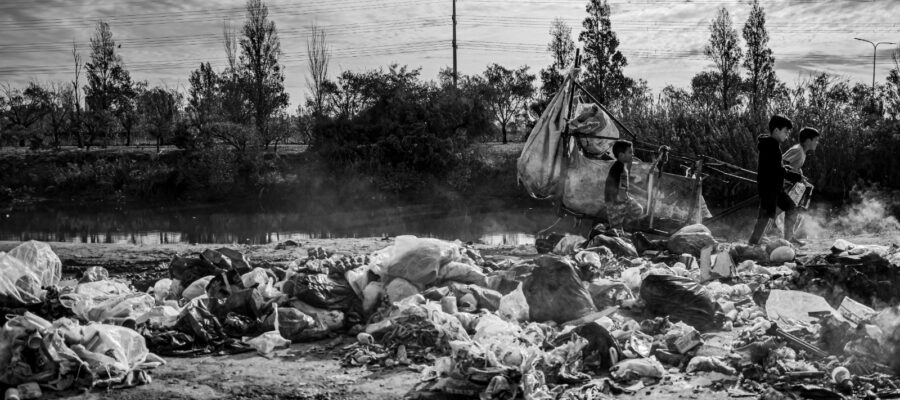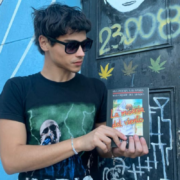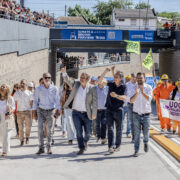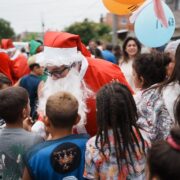Emilia Novo
Imagen por Daniela Maccarrone para AUNO
Benjamín and Ramiro are no more than ten and fourteen years old and every other day they come to visit us at the office door. We eat panchitos, empanadas and salami sandwiches. We walk along the passage that crosses one of the main streets. We stroll and chat.
― Did you see those two over there? ― He says pointing to two other boys begging at the traffic lights. ― Don’t help those guys, they steal from the old ladies, they’re such a bunch of assholes.
Ramiro likes to paint, so on whatever surface we find, could be a bench, a bus stop or the doorway of a building, we painted them in colors paper and pens. They talk about money a lot. They ask us how much is the cell phone we have or the glasses we wear. Benjamin is physically smaller, he cries often and gets upset when there is no milanesa to eat. They take care of each other as if they were brothers, even though they met in the street. We usually go back to the office to give them clothes, slippers or blankets that we collect.
― I don’t like those shoes. Don’t you have any cooler ones? ― says Ramiro pointing to the Salomon sneakers I’m wearing.
― Why did you give him a cap and not me? I want one too!
We laugh, they make me promise to invite them to play GTA on the Play 4. They leave, generally shouting at each other, swearing to behave themselves and not to mess with the police. As long as the cops treat them well, they say.
Downtown La Plata, the capital of Buenos Aires province, is always chaotic: honking horns, traffic jams, masses of people coming and going. No one respects the signs despite the frustrated attempts of the civil guard with their fluo green vests. Most of the government offices are within a five-block radius of this intersection, as are the courthouses, movie theaters and other important buildings.
Our office is among these buildings, and we are in charge of the area of Children and Adolescents at a public organism. As a control organism, we check or try to make sure that the state institutions work as they should. We call, accompany and advise people with doubts related to the subject. In addition to the office, our work space includes children’s homes, penitentiary units and schools.
But it is not only adults working in these streets, rushing and stressing to arrive on time; gangs of children who look like armies walk around aimlessly: they go through all the shops in the city looking for donations to eat and, sometimes, taking them by force. Some are no more than eight years old, accompanied by their older siblings and even their very young parents.
They rest in the sun, winter here is humid, the cold feels wet on the skin. The boys enjoy the corners where they can get some warmth and where the police have already desisted from running them off. There are mattresses, blankets and bags of food left by people passing by. It is always hard to establish how old they are, they are always very skinny but their attitudes are in accordance with adults. They speak fluently and are usually much sharper than you when it comes to answering.
Childhood and poverty in Argentina
In Argentina the eighth Survey of Households with Children and Adolescents, published by the local branch of UNICEF this month, reveals that one million girls and boys go to bed without dinner, a figure that rises to one and a half million if we include those who skip meals during the day. In the case of adults living in such households, the number rises to 4.5 million, in many cases because they prioritize feeding their children. The study also shows that 10 million girls and boys in Argentina eat less meat and dairy products compared to last year due to lack of money, in a context in which, in addition, the income of almost half of the households with children is not enough to cover basic food, health and education expenses.
This study shows that at least 5.6 million Argentine children and adolescents have at least one right violated. They attribute this to the growing inflation that the economy has suffered since approximately 2016, data collected by INDEC and from the Permanent Household Survey (EPH) at the end of 2023.
The 2024 budget on childhood, shows a 75% drop, compared to the same period in 2023. This implies restrictions linked to sensitive policies for children and adolescents, such as family allowances, food policies, support for the National Early Childhood Plan, among others.
The current Minister of Economy of Javier Milei’s government, Luis Caputo, announced at the beginning of this year that “The minimum, vital and mobile salary is twenty percent below inflation”. This directly affects the most vulnerable households and precarious workers, affecting their sons and daughters.
Homes and reformatories.
The children do not come from out nowhere, one of the most common origins are the state or municipal homes. There they are victims of mistreatment, bad food and even abusive situations. How can we expect them to want to live in those places? Why don’t we give them another alternative?
Law 26.061 stipulates the Rights of Children and Adolescents in our country. This law establishes the right to a home, education and respect for their autonomy. The emotional and cognitive damage caused in these children from an early age; violence and abandonment as central psychic traces they reproduce in their youth and adulthood. This law seeks to address the growth of delinquency in recent years as a clear result of the neglect of children by the government.
Given the lack of funding, the agencies that should take care of children in a territorial way, are underfunded. There are few workers who still resist, but their job can failry be seen as militancy or activism since their salaries are not even close to the minimum wage. On the other hand, the state convivial homes, where children…. are in the same situation; in the face of abandonment and zero state regulation, they are usually hostile and terrifying spaces for the kids as if it were a cliché from a movie about orphans.
Benjamin, our guide concerning La Plata street life, always tells us:
― I don’t like to talk to some of the older ones because they want to lock me up.
One of the area’s concerns is that children often end up in reform schools for stealing. They explained tthey do not have a punitivist position, understanding the vulnerability to which children are exposed and the risk involved in the act of committing a crime. But the police tend to show no mercy, especially now with the approval of the Basic Law that lowered the age of imputability to 13 years old. They take kids to the police station, hold them, assault and beat them. More and more traditional media justify the beating of minors, not understanding the previous situations of the children.
I don’t want your help
A few months ago, when the weather was still warm, we were called because there was a kid sleeping in the doorway of one of the most luxurious buildings in downtown. When we arrived on the scene with other colleagues, we saw him. He looked no more than nine years old, but his giant blue sports jacket was obscured from view, sleeping on his back with his mouth open in the sunlight. It was about thirty degrees and yet he was covered with a blanket.
His forehead was sweating, a fly was coming out and going in his mouth. We managed to wake him up after several attempts, legally we could not struggle or touch him too much. The boy manages to open one eye and nimbly pulls out a little knife from his pocket. He points it at us. He looks at us with his giant brown eyes full of rage.
― Get out of here or I’ll cut you!
We tell him we’re just here to help him and all the talk about how kids shouldn’t live on the street. Absurd, as always. The boy looked at us threateningly, shouting at us to leave. We only managed to calm him down when we called the police; only then he back down:
― Santiago is my name and I am thirteen years old. But don’t call the police, the last time one did this to me….
He lifts up his pants to show us a wound with six stitches in his right knee, we did not ask for details. He told us that he lived in the park with other boys his age and older people. He had no family and had run away from two homes, in one of them hurting one of the caregivers, as the operator of the Provincial Childhood Agency told us hours later. The operator, tired, tells us that he is going to resign because he has not been paid by the municipality for two months.
In most of the cases, children in this situation are like Santiago: impossible to treat. Exposure to a violent upbringing, neglect by the state and life on the street leads these children to react with the tools that absence has given them. No matter our good intentions, we are the enemy.
That day, Santiago walked away with his things, wandering aimlessly once again. We respected his wish and he didn’t come with us to the children’s office, because we knew they were not going to give him the answers and solutions he needed. There are many like him, and more and more of them. Recently, I saw Ramiro and Benjamin consuming what I believe to be paco with a lighter and a spoon. We thought that this destiny was avoidable but we understood that this is far beyond us as workers. We cried, we were angry and furious, we thought we were doing things right. But sometimes it’s not enough
As long as public policies continue to be underfunded and there are no longer spaces for housing, education and affection for these children, we will continue to condemn them to a hostile and irremediable future. It may not be too late to demand a dignified life for all in our territory.
Article worked during AUNO’s English for Journalist Course
Image worked during AUNO’s Introduction to Photojournalism Course
MEN / JJR



















